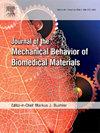A benchmark of muscle models to length changes great and small
IF 3.3
2区 医学
Q2 ENGINEERING, BIOMEDICAL
Journal of the Mechanical Behavior of Biomedical Materials
Pub Date : 2024-09-20
DOI:10.1016/j.jmbbm.2024.106740
引用次数: 0
Abstract
Digital human body models are used to simulate injuries that occur as a result of vehicle collisions, vibration, sports, and falls. Given enough time the body’s musculature can generate force, affect the body’s movements, and change the risk of some injuries. The finite-element code LS-DYNA is often used to simulate the movements and injuries sustained by the digital human body models as a result of an accident. In this work, we evaluate the accuracy of the three muscle models in LS-DYNA (MAT_156, EHTM, and the VEXAT) when simulating a range of experiments performed on isolated muscle: force–length–velocity experiments on maximally and sub-maximally stimulated muscle, active-lengthening experiments, and vibration experiments. The force–length–velocity experiments are included because these conditions are typical of the muscle activity that precedes an accident, while the active-lengthening and vibration experiments mimic conditions that can cause injury. The three models perform similarly during the maximally and sub-maximally activated force–length–velocity experiments, but noticeably differ in response to the active-lengthening and vibration experiments. The VEXAT model is able to generate the enhanced forces of biological muscle during active lengthening, while both the MAT_156 and EHTM produce too little force. In response to vibration, the stiffness and damping of the VEXAT model closely follows the experimental data while the MAT_156 and EHTM models differ substantially. The accuracy of the VEXAT model comes from two additional mechanical structures that are missing in the MAT_156 and EHTM models: viscoelastic cross-bridges, and an active titin filament. To help others build on our work we have made our simulation code publicly available.

肌肉模型的基准,以适应大大小小的长度变化
数字人体模型用于模拟车辆碰撞、振动、运动和跌倒造成的伤害。只要有足够的时间,人体的肌肉组织就能产生力量,影响身体的运动,并改变某些伤害的风险。有限元代码 LS-DYNA 通常用于模拟数字人体模型在事故中的运动和受伤情况。在这项工作中,我们评估了 LS-DYNA 中的三种肌肉模型(MAT_156、EHTM 和 VEXAT)在模拟对孤立肌肉进行的一系列实验时的准确性:最大和次最大刺激肌肉的力-长度-速度实验、主动延长实验和振动实验。之所以包括力-长度-速度实验,是因为这些条件是事故发生前肌肉活动的典型条件,而主动拉长和振动实验则模拟了可能导致损伤的条件。三种模型在最大和次最大激活力-长度-速度实验中的表现相似,但在主动拉长和振动实验中的反应明显不同。VEXAT 模型能够在主动拉长过程中产生生物肌肉的增强力,而 MAT_156 和 EHTM 产生的力都太小。在振动响应方面,VEXAT 模型的刚度和阻尼与实验数据非常接近,而 MAT_156 和 EHTM 模型则差别很大。VEXAT 模型的准确性来自于 MAT_156 和 EHTM 模型中缺少的另外两个机械结构:粘弹性交叉桥和活性 titin 丝。为了帮助其他人在我们的工作基础上更进一步,我们公开了我们的模拟代码。
本文章由计算机程序翻译,如有差异,请以英文原文为准。
求助全文
约1分钟内获得全文
求助全文
来源期刊

Journal of the Mechanical Behavior of Biomedical Materials
工程技术-材料科学:生物材料
CiteScore
7.20
自引率
7.70%
发文量
505
审稿时长
46 days
期刊介绍:
The Journal of the Mechanical Behavior of Biomedical Materials is concerned with the mechanical deformation, damage and failure under applied forces, of biological material (at the tissue, cellular and molecular levels) and of biomaterials, i.e. those materials which are designed to mimic or replace biological materials.
The primary focus of the journal is the synthesis of materials science, biology, and medical and dental science. Reports of fundamental scientific investigations are welcome, as are articles concerned with the practical application of materials in medical devices. Both experimental and theoretical work is of interest; theoretical papers will normally include comparison of predictions with experimental data, though we recognize that this may not always be appropriate. The journal also publishes technical notes concerned with emerging experimental or theoretical techniques, letters to the editor and, by invitation, review articles and papers describing existing techniques for the benefit of an interdisciplinary readership.
 求助内容:
求助内容: 应助结果提醒方式:
应助结果提醒方式:


